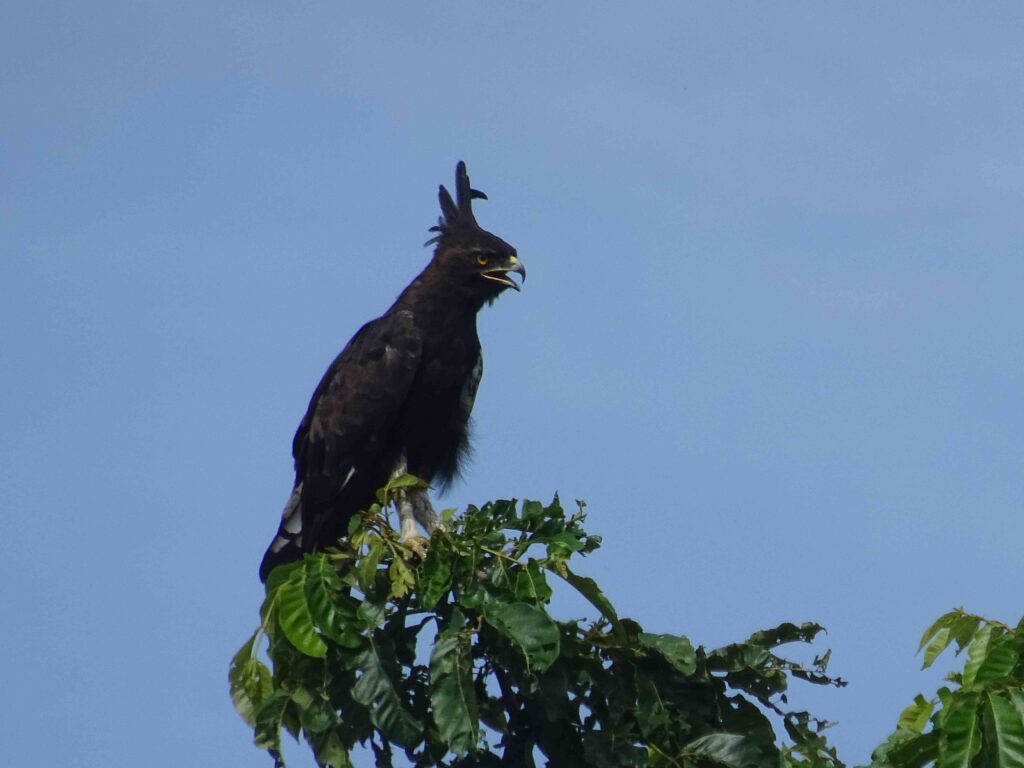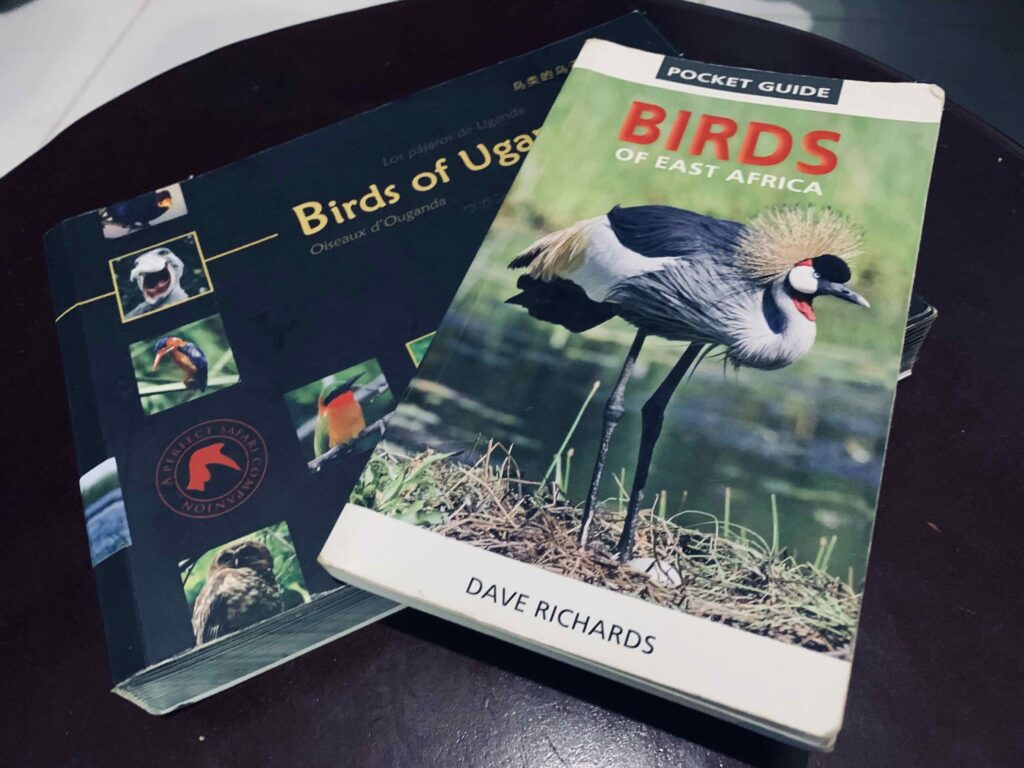Table of Contents
- Birdwatching for beginners: What do you need?
- Birdwatching for beginners: 7 helpful items
- Birdwatching for beginners: What you don’t need
- Recap: Birdwatching for beginners in East Africa
Welcome to my birdwatching for beginners guide!
Birdwatching is one of the most accessible hobbies in the world, and the stark truth is this: you don’t need anything to go birdwatching.
There, I’ve said it.
You can simply walk outside and look above you before waiting to see what birds make their way into your immediate surroundings. This is the reason why I enjoy bird watching so much, as you can just pop outside for five minutes to see what’s around.
Still, there are certain items that make birdwatching that little bit easier, particularly if you’re heading out into woodland for an actual bird-watching trip, or planning to go bird-watching on an upcoming safari in Africa.
But before diving in and buying all the latest and most expensive gear, the reality is you probably have most – if not all – of the items you could possibly need to go bird-watching already.
Therefore, I’ve put together this super helpful checklist that includes everything I think you need to go bird-watching as a beginner. I’ve also included some tips on what you don’t need, regardless of what you might have heard from an experienced birder.
Ready to dive into our list? Let’s go.
Birdwatching for beginners: What do you need?
Instead of telling you what you need to take birding, I’ve decided to list seven things that I think you might find helpful as a beginner bird watcher. You can agree or disagree with me; it’s entirely up to you!
Birdwatching for beginners: 7 helpful items
So, here’s my suggested checklist, followed by a closer look at why I think you can utilize these items during your upcoming birding trip to East Africa.
An open mind
Okay, so the first thing isn’t actually a “thing,” but it’s perhaps the most important point on this entire list. When you’ve decided to go bird-watching, you need to adopt an open mindset and manage your expectations.
What I mean by this is that birds come and go as they please, and you’re not guaranteed to see one species over another.
If you leave home expecting and hoping more than anything to see an elusive shoebill, for instance, on your first-ever trip, you might end up disappointed.
While it’s nice to think of birds that you would like to see, you shouldn’t set any expectations of what you will see on your upcoming trip.
Instead, regard the trip as an opportunity to be present in the great outdoors, and see what you discover.
This way, you won’t be bitterly disappointed if you don’t spot a rare bird that you had very little chance of seeing in the first place.
Time and patience

Adding to my previous point, you need to be patient when you’re out birding. Birds don’t adhere to the same strict patterns that we do, and you will find that different birds come and go throughout the day.
While I’m not saying that you need to go and sit in the bush all day just to see something, you equally can’t expect to rock up and see all the native species in a specific area in a matter of minutes.
So many of us (myself included!) are guilty of wanting things to happen right away. With birding, you need to be patient as you observe the natural world around you.
I actually think bird watching is an excellent mindfulness activity, and it encourages people to focus their attention on the present moment.
As such, it can be a great way to de-stress and unwind, so long as you don’t get agitated about not seeing a specific bird species!
The right clothing
Okay, so now it’s time to look at the practical items on our checklist. When you go birding, you need to dress appropriately. Here are my suggestions:
- Long-sleeved shirts to keep the insects and sun at bay.
- Lightweight pants with pockets – cargo pants or something similar are ideal.
- Long socks and comfortable footwear. What you wear on your feet depends on where you’re going, but if you’re planning to follow trails, hiking boots are your best bet.
- A hat and sunglasses if you’re birdwatching in the summer.
- Choose dull colors that help you blend into your natural surroundings. Birds don’t like white and bright colors, so bear this in mind when picking your outfit.
In addition to these items, you should dress for the weather. Obviously, if you’re birding in East Africa during the rainy season, take some waterproof clothing with you.
But as you can see from the list, you don’t need to wear anything fancy to go birding. Just wear some comfortable clothes that you already have in your closet and get out there!
Binoculars
Binoculars aren’t essential for bird watching, but they do help considerably. The best thing about birding binoculars is that they help you keep your distance from birds.
Most birds are scared of humans, so if you get too close in an attempt to spot a certain species, you might scare them away before you’ve been able to take a good look.
However, investing in a pair of binoculars is a decent way to improve your overall bird-watching experience.
There’s absolutely no reason to splash the cash on a pair of binoculars if you don’t want to. In fact, you can grab a great pair of binoculars for birding on Amazon for less than £30, which will serve you well as you head out into the woods.
Top tip: When you’re looking for birding binoculars, pay attention to the power magnification and lens width. For instance, a pair might be expressed as 12×42, which means it has 12x power magnification and 42mm lenses. This would be ideal for getting you started.
A camera
As is the case with binoculars, you don’t need a camera to go bird watching. If you want to get out into nature and see what’s around you, there’s absolutely no need to take pictures at the same time, if you don’t want to.
Personally, I love taking pictures of birds, so I take my camera with me when I go birding, but that’s just my preference. I have a Sony bridge camera with 30x optical zoom.
Is it the best camera in the world? No.
Does it enable me to take awesome pictures of birds that I can share with my family and friends? Yes.
As I’ve got more into bird watching, I have considered investing in a new camera, but I haven’t taken the plunge yet.
My advice here is that you don’t need to spend thousands of dollars on an impeccable wildlife camera if you don’t want to.
A digital camera with zoom capabilities is more than sufficient for anyone with interest in watching and taking pictures of birds. If you have one already, great. But if not, you can hop onto Amazon and pick up a great camera for a few hundred dollars.
One thing I would say is that you probably need a camera instead of relying on your smartphone. The reality is that unless a bird is super close to you, a smartphone camera won’t be able to do the shot justice.
Notebook/Journal
I find it helpful to carry a small journal with me when I go bird watching. That way, I can make notes about the birds that I sight.
For instance, I have a little journal that I keep on my desk that includes the birds that I see in and around my garden. In Uganda, so many birds I’m unfamiliar with come and go, so my notebook always comes in handy.
I’ve got to know all of the species pretty well that I share a home with, but I’m always thrilled when I see a new bird enter the fray!
Having my journal on hand is my way of learning (and remembering!) the species native to my area as I check through my field guide to help me. What is a field guide, I hear you ask? More on that below.
Field guide

A field guide is basically a book that consists of pictures and descriptions of the bird species that are native to a certain area.
As a beginner birder, a field guide will help you enormously, as it will provide you with tips on how to identify a species while serving as a pictorial reference guide when you’re completely unsure of what you’ve just seen!
Of course, you can use the internet to help you in this day and age, but I love nothing more than flicking through a field guide to identify a species that I’ve just spotted.
I use two field guides right now to help me. The first is a pocket guide containing the Birds of East Africa, and the second is a charming coffee-table book containing all the birds of Uganda specifically.
I use the two in tandem, but I like to carry the pocket guide around with me when I’m on the road. I’m headed to Kenya next month, and I will no doubt have my pocket field guide in my backpack.
Birdwatching for beginners: What you don’t need
As you can see from my checklist, the truth is that you don’t need a great deal of things to go bird-watching. Therefore, it’s a really easy hobby to get into.
Before bringing this article to a close, I just want to touch on a few things that I don’t think you need to go birding. In other words, I don’t want them to serve as barriers to entry!
The best and most expensive gear
As is the case when you’re starting any hobby, a quick Google search will reveal a whole host of items that might at first seem essential to your life as a bird watcher.
And before you know it, you’ve spent thousands of dollars on binoculars, a camera, and a range of other high-tech equipment that you don’t actually need.
While everyone is entitled to spend whatever they like on gear, I just want to reemphasize the fact that you don’t need the best and most expensive equipment to enjoy bird watching.
You can always upgrade your equipment as you get more into bird watching if you like, so don’t feel as if you need to spend the big bucks when you’re just getting started.
Special clothing
Living in Uganda, I marvel at the fact that so many tourists dress in the same way to come on safari! Be it a wildlife trip or a birding experience; people seem to wear super expensive clothes that they’ve obviously ordered specifically for their safari.
But to go birding, you don’t need to wear anything special. You certainly don’t need to order expensive pants or shirts to try and look a certain way.
Just make sure your clothing doesn’t cause you to stand out when you go birding, as bright colors are likely to scare away the birds.
My advice would be to wear clothes that you already have, instead of investing hundreds of bucks in the latest brands of clothing.
Knowledge of birds
Finally, I want to reassure you that you don’t need to know a single thing about birds before heading out on your first bird-watching trip.
The best way to learn about something is to go ahead and find out for yourself. Even if you can’t identify one single species during your first outing, it doesn’t matter.
I invite you to head out into the natural world and look around you. You can then use a field guide (or your smartphone) to try and discover what the bird is that you’ve just spotted.
And that, in a nutshell, is my favorite thing about birding! You’ll be an expert in no time at all.
Recap: Birdwatching for beginners in East Africa
So, to recap, here are seven things that can help you when you’re just starting out as a bird watcher and are about to undertake a trip in East Africa:
- An open mindset
- Time and patience
- The right clothing
- Binoculars
- A camera
- Notebook/journal
- Field guide
If you have any other tips on items that will help beginner birders, please feel free to drop your suggestions in the comment section below!
Otherwise, happy birding, and I hope you’ve found my birdwatching for beginners guide helpful!
If you’re planning to take your kids’ birdwatching in East Africa, this guide to birding with children will help you prepare for the adventure! You might also find this informative guide to what not to wear birding helpful, ahead of your first birdwatching trip in East Africa!




